Solo hiking from Kamikochi to Karasawa: A jewel in autumn
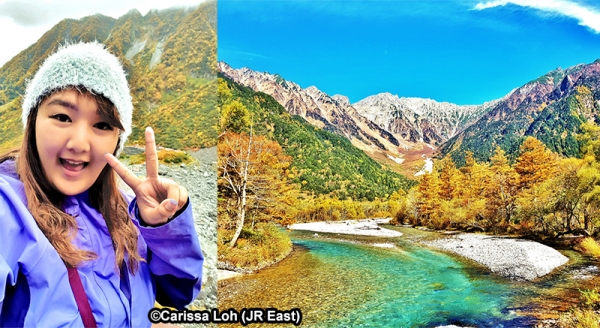
Updated as of 23 May 2024
Originally published on 18 April 2020
Japan is a country that I will never get tired of visiting. Although I have never lived there, I have visited a total of 43 times for both work and leisure, and have travelled to all of Japan’s 47 prefectures. If you ask me what my favourite place is, without hesitation my answer will always be Kamikochi (上高地 Kamikōchi) in the Northern Japanese Alps (北アルプス Kita-Arupusu).
Ever since I first visited in 2011, Kamikochi has sealed its spot as my absolute favourite place in Japan, and possibly the world. At an altitude of 1,500m, it is a beautiful, pristine highland region where the view of the clear blue Azusa River flowing in front of the Hotaka mountain range is simply mesmerising. Since 2011, I have visited Kamikochi seven times, and at the end of each visit I am always sure of two things—one: I will be back, and two: I will venture deeper into the mountains! The deeper into the trails you go, the less people there are, and the more peaceful and magical the hike becomes.
For me, visiting Kamikochi is akin to undertaking a spiritual journey to rejuvenate my mind, body and soul. Kamikochi made me fall in love with nature and hiking, and will forever hold an irreplaceable spot in my heart. Beyond just the iconic Kappabashi, I will show you the journey up to Karasawa Cirque (涸沢カール Karasawa kāru)—the jewel of Kamikochi and a spectacular symphony of colour in autumn.
Where is Kamikochi?
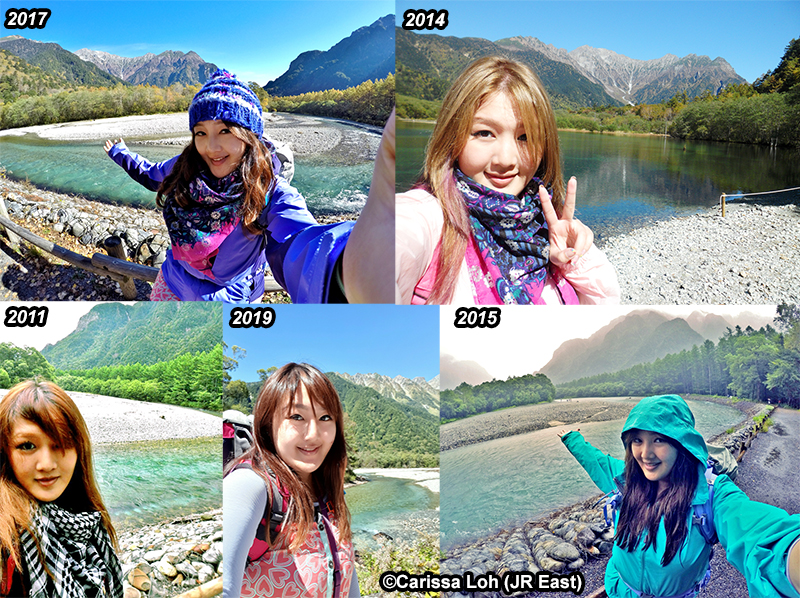
Visits to Kamikochi over the years. (Image Credit: JR East / Carissa Loh)
Located in the mountainous Nagano Prefecture, Kamikochi’s name literally means “the grounds where gods descended”, and comes from the arrival of the Shinto god "Hotaka no mikoto" (穂高見命), who was believed to have descended on Mount Oku-hotakadake (奥穂高岳). It is no wonder that the scenery here is so heavenly! Temperatures rarely exceed 20ºC, and gets cooler the further up you climb.
Nestled among soaring peaks and deep valleys, the Northern Japanese Alps region is a mecca for climbers, with Kamikochi being the gateway for various hikes into these mountains. As the number of visitors grew, Kamikochi banned the entry of private cars to preserve its pristine beauty, so you can only get here by authorised buses and taxis. Just 90 minutes from Matsumoto City (松本市 Matsumoto-shi) via public transport, Kamikochi can be a convenient day trip for anyone, or a multi-day trip for more avid hikers.
Like most people, my first visit to Kamikochi in 2011 was the typical beginner’s route: a 1-hour walk from Taisho Pond to Kappabashi. Subsequently, I ventured slightly further up to Myojin Pond. For years, I was content with the 3-hour Taisho Pond → Kappabashi → Myojin Pond → Kappabashi loop, but after my first climbing experience (Mount Fuji in 2016), I decided that I was ready to attempt the 6-hour climb to Karasawa Cirque in 2018. So far, Karasawa Cirque is the furthest point that I have been to, but I hope to attempt Mount Yari, the iconic spearhead mountain that is Japan’s 5th highest peak in future.

Karasawa on a file (left) and Karasawa in real life (right). (Image Credit: JR East / Carissa Loh)
When I first visited Kamikochi in 2011, it was my first time travelling alone, and my first time going hiking. At one of the souvenir shops, I chanced upon a file with a striking photo of Karasawa Cirque on it, and remembered thinking to myself, “This place looks amazing! I don’t know when, but someday I will go there”. It took 7 years, but I finally made that hike in 2018. And in 2019, I did it again.

View around Karasawa Cirque. (Image Credit: JR East / Carissa Loh)
At the heart of the dramatic Hotaka peaks, Karasawa Cirque is a 6-hour hike / climb from Kappabashi and is best known for its explosion of colours in autumn. Due to its higher altitude at 2,350m, the peak period for autumn foliage here is around the last week of September to the first week of October. Trust me when I say that the vibrant colours and panoramic alpine scenery along the route are second to none, and make the climb sooo worth it. Unlike Mount Fuji where there is no view on the way up and the summit is the goal, for Karasawa both the climb and the destination are equally enjoyable.
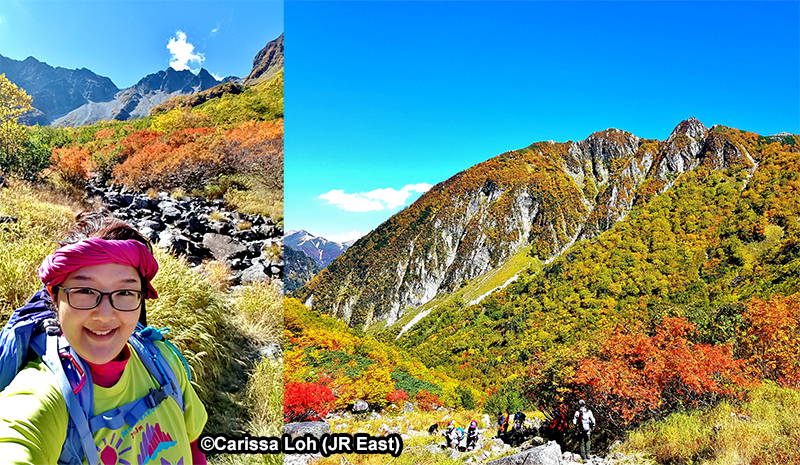
On the way up to Karasawa Cirque. (Image Credit: JR East / Carissa Loh)
At first, you might think that a 6-hour climb sounds daunting, but with some perseverance, even beginners can hike up to Karasawa without much difficulty. Now, let me take you on a step-by-step journey from Kamikochi to Karasawa Cirque!
Route
Travelling times
Matsumoto/松本 → (90-minute bus and train ride) → Taisho Pond/大正池 → (1-hour walk / 8-minute bus ride) → Kamikochi Bus Terminal/上高地バスターミナル→ (5-minute walk)→ Kappabashi/河童橋 → (1-hour walk) → Myojin Bridge/明神橋 → (1-hour walk) → Tokusawa/徳沢 → (1-hour walk) → Yokoo/横尾 → (1-hour climb) → Hontani Bashi/本谷橋 → (1.5-hour climb) → S Gare/Sガレ → (1-hour climb) → Karasawa Cirque/涸沢カール
Recommended plan
Day 1: Matsumoto → Taisho Pond → Kappabashi → Myojin Pond →Tokusawa (overnight)
Day 2: Tokusawa → Yokoo → Hontani Bridge → S Gare → Karasawa Cirque (overnight)
Day 3: Karasawa → Matsumoto
Taisho Pond

Taisho Pond in the early morning. (Image Credit: JR East / Carissa Loh)
Most hikes start off at Taisho Pond (大正池 Taishō-ike), where the trail is flat and easy-to-walk. If you can, I highly recommend visiting in the morning, when the trees glisten with morning dew, the magnificent peaks of Mount Yakedake and the Hotaka mountain range are shrouded in mist, and the pond’s tranquil waters reflect this scenery clearly. An early morning hike here offers a tiny glimpse into the magic of nature. I have literally spent up to 2 hours just standing by the side of the pond, gazing at the peaceful scenery and getting lost in my thoughts.
Kappabashi

Kappabashi in summer. (Image Credit: Matsumoto City / JNTO)
About 1-hour from Taisho Pond is Kappabashi (河童橋), a suspension bridge over the Azusa River. This picturesque scene of Kappabashi in early summer with lush green leaves, against a backdrop of the snow-capped Hotaka mountain range, with the Azusa River flowing in the foreground is the poster image for Kamikochi. You have probably seen it before, haven’t you?
This scenic bridge is only a 5-minute walk from the Kamikochi Bus Terminal, and is where most of the souvenir shops and hotels are located. If you’re feeling a bit hungry, I highly recommend getting the sanzokuyaki (山賊焼 ginger fried chicken) and delicious Azumino Yoghurt Drink as snacks before continuing on.
Myojin Pond
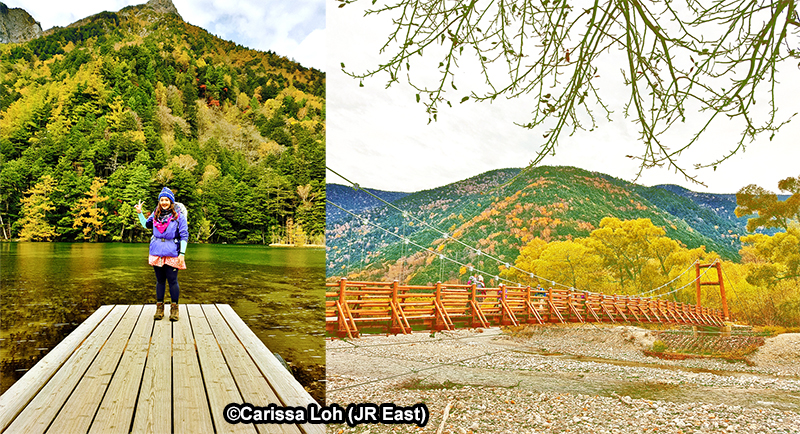
Myojin Pond (left) and Myojin Bridge (right). (Image Credit: JR East / Carissa Loh)
A 1-hour walk from Kappabashi takes you to Myojin Bridge (明神橋 Myōjinbashi). I like to cross the bridge to take a short detour to Myojin Pond (明神池 Myōjin ike), where the mystical Hotaka Shrine is located. The shrine is dedicated to Hotakami-no-mikoto, the Shinto god whose descent was how Kamikochi got its name. Despite its small size, the pear-shaped pond’s waters clearly reflect the surrounding scenery, creating a beautiful view in all seasons. The pond was formed when sediments from Mount Myojin filled a tributary of the Azusa River.
With unbelievably clear light-blue waters, the Azusa River is one of my favourite things about Kamikochi. This beautiful river is my constant companion for half the trip to Karasawa Cirque, until we part ways at Yokoo. The sound of its flowing water becomes the soothing background music for my hikes, drowning away stressful thoughts and calming my mind. The negative ions it releases brings positive vibes and reenergises my weary soul. Perhaps it is just a mindset, but being surrounded by nature always makes me feel at ease, and recharges me when I feel drained from work and life.
Tokusawa

Tokusawaen, a comfortable mountain hut at Tokusawa. (Image Credit: JR East / Carissa Loh)
When making the trip to Karasawa, I like to spend the first night at Tokusawa (徳沢), the last part on the trail where showers are available in the mountain huts. Bonus: They also have indoor onsen! From here on out, subsequent mountain huts do not have showers. Having stayed at both of Tokusawa’s main huts—Tokusawaen (徳澤園) and Tokusawa Lodge (徳沢ロッジ)—I must say that I really loved Tokusawaen! Mountain huts usually have a reputation for being squeezy and lacking in privacy, but at Tokusawaen, even for shared rooms you get your own space with a curtain for privacy. The meals are also very tasty—serving up delicious dishes made with ingredients that are locally sourced from all around Nagano.
Yokoo / Hontani Bashi
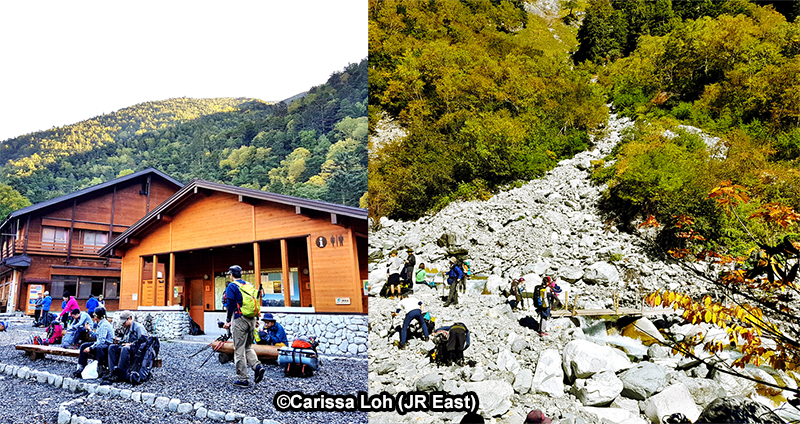
Yokoo Sanso (left) and Hontani Bashi (right). (Image Credit: JR East / Carissa Loh)
The 1-hour trail from Tokusawa to Yokoo (横尾 Yokoō) is still a flat and easy-to-walk path. Yokoo is where the last mountain hut (Yokoo Sanso) and toilet break are until Karasawa Cirque. Be sure to cross the Yokoo Oohashi Bridge and follow the forested path towards Hontani Bashi (本谷橋). If you do not cross the bridge at Yokoo, you will end up heading towards Mount Yari! It takes about 1-hour for this section, and many people take an extended break at Hontani Bashi to eat their packed breakfasts, drink water, and rest. Prepare yourself, because from Hontani Bashi onward, the path becomes significantly steeper, and will be a zigzag climb of rocks and more rocks.
S Gare
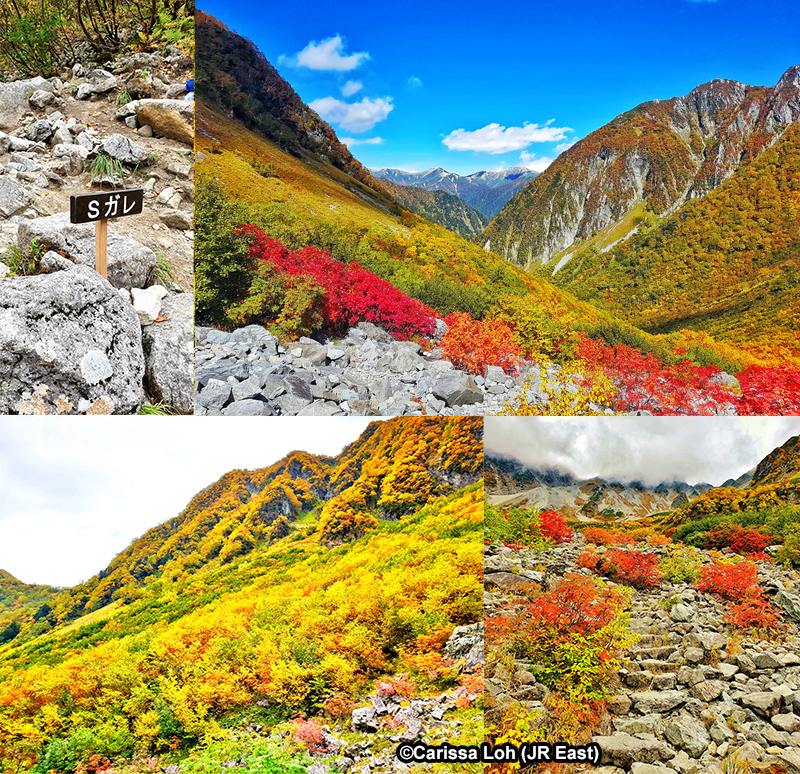
View on the way to Karasawa. (Image Credit: JR East / Carissa Loh)
Tada! Once you pass the S Gare (Sガレ), 1.5 hours from Hontani Bashi , the view of the colours of Karasawa and the Hotaka mountain range are incredible—an explosion of colours awaits you. Although this is one of the most exhausting portions of the hike, it is also one of the most scenic. The magnificent views almost make me forget how tiring the hike was…almost. With a wide and open space, you can take your time, take as many breaks as you want, and enjoy the stunning vistas and radiant colours. If I could only use one word to describe it, autumn here is ethereal. It really felt like I had stepped into another world—the grandeur and beauty of the scenery is truly otherworldly.
Karasawa Cirque
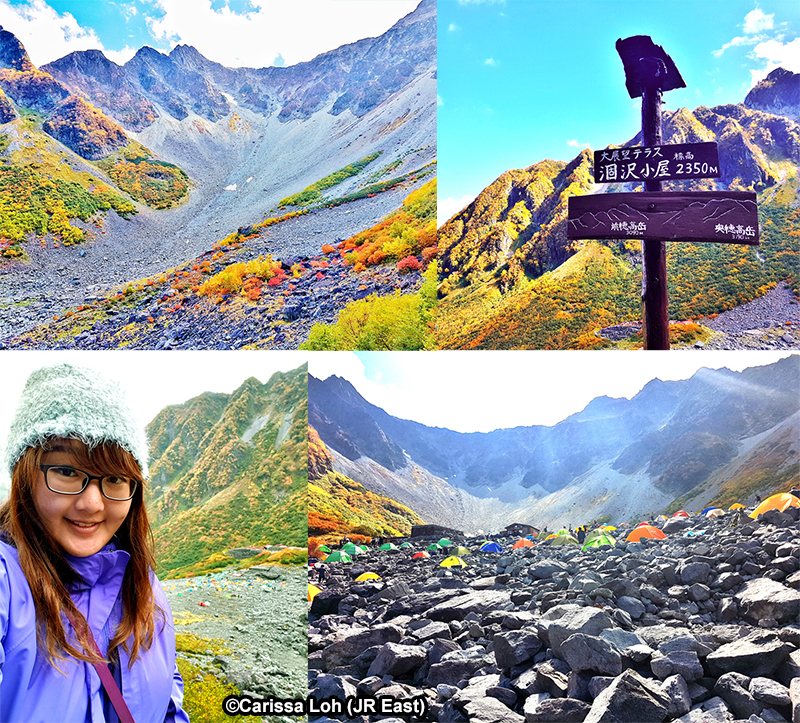
Made it to Karasawa Cirque! (Image Credit: JR East / Carissa Loh)
Just one more hour of climbing from S Gare and you will finally reach Karasawa Cirque. The steep rocky climb opens up into a wide valley, with steep, high walls surrounding you. This is the "Cirque" in Karasawa Cirque. Being very wide and high, it is difficult to capture it all on a phone camera, but I tried… Finally, it is time to relax, sit back and take in the amazing alpine panoramas! Autumn here is gorgeous, and the radiant foliage draws incredible crowds from all over Japan. You will be surprised at the number of people who make the trip to Karasawa in autumn—there are even tour groups of just senior citizens. From Karasawa, it is possible to climb up to Kita-hotakadake peak (3.5 hours), and Oku-hotakadake peak (3.5 hours), though these are for more experienced climbers. Maybe someday I will attempt them, but for now, Karasawa is enough for me.
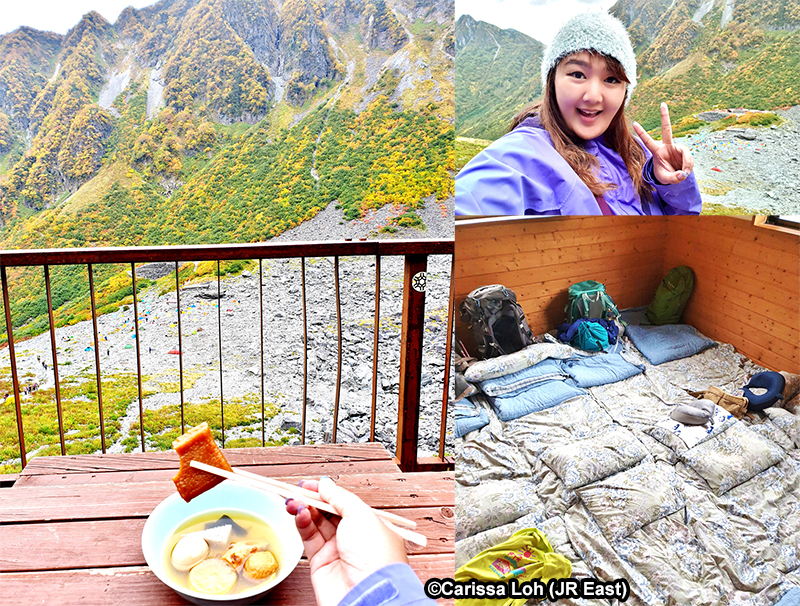
Taking a break at Karasawa Goya. (Image Credit: JR East / Carissa Loh)
The first thing I do after arriving is to order a bowl of warm oden. Despite the warm colours of the plants, in autumn the temperatures are nothing but warm. They hover around 5–10ºC, even dropping to 0ºC at night. Sitting on the veranda and enjoying a hearty bowl of oden while gazing at the scenery is the perfect way to warm up and relax!
The two mountain huts here are Karasawa Hütte (涸沢ヒュッテ) and Karasawa Goya (涸沢小屋). Perched on the side of a rock, Karasawa Goya is the higher of the two, and offers a birds’ eye view of the valley and Karasawa Hutte below! I stayed at Karasawa Goya both times, and luckily for me, both times I stayed (weekdays), I was able to get a futon to myself. Most mountain huts will not refuse entry, so when the crowds peak during summer and the autumn foliage period, 2–3 people might have to share one futon. Still, be sure to call and book your spot well in advance.

Tent city during the day (left) and at night (right). (Image Credit: JR East / Carissa Loh)
Staying at a mountain hut sets you back by about ¥10,000 a night, including dinner and breakfast. But other than mountain huts, tents are also an accommodation option. At Karasawa Cirque, the more experienced hikers pitch their own tents on the rocky patch in front of the cirque, earning the nickname “tent city”. Part of me wants to try this someday, but I have no idea how to set up a tent, and they are heavy! Plus, the ground is very rocky, so the tent dwellers must either be pretty tough, have very thick sleeping bags, or have a high tolerance for discomfort...
When night falls, temperatures drop and you notice two things—lit up colorful tents dotting the valley, and the canopy of stars shining above. When there are no clouds, you can see tens of thousands of stars dazzling in the night sky. Coming from a city with one of the highest light pollution levels in the world, the sight of the stars twinkling brightly like diamonds in the pitch-black sky was so enchanting to me! I never thought that night time could be so dark, or that it was possible to see so many stars at once. If you are lucky, you might even see the Milky Way.

Karasawa Cirque’s towering wall. (Image Credit: JR East / Carissa Loh)
I feel most relaxed at Karasawa, because even though the accommodation at Tokusawa was more comfortable, work calls and emails still came flooding in. At Karasawa, cell reception was practically non-existent, and it felt great to get shut off from the rest of the world for a while, slowly taking in the sublime beauty of the views, focusing on my thoughts and letting go of worldly cares for a moment. Although I feel physically tired, I am also mentally energised and refreshed, and I want to experience this rejuvenation again. This feeling is what makes me want to come back.
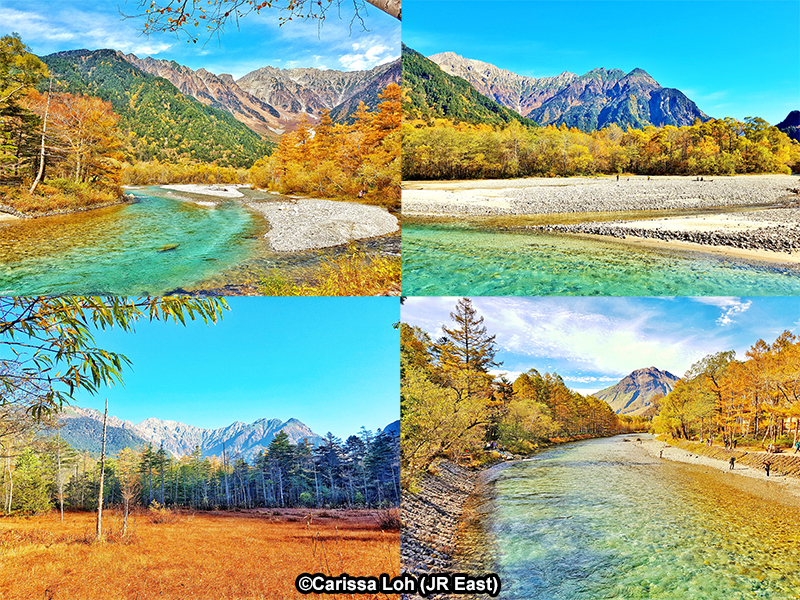
Autumn at Kamikochi, near Kappabashi Bridge. (Image Credit: JR East / Carissa Loh)
Even if you do not make it all the way to Karasawa Cirque, Kamikochi is still an awe-inspiring place to visit with so much to see at every corner. Who knows, maybe someday in the future, after a few trips to Kamikochi, you too will make the journey deeper into the mountains and be richly rewarded with the scenery!
Getting there
To get to Kamikochi, take a 30-minute train ride on the Matsumoto Dentetsu Kamikochi Line (松本電鉄上高地線) from Matsumoto Station (松本駅) to Shin-Shimashima Station (新島々駅), followed by a 60-minute bus ride.
JR EAST PASS (Nagano, Niigata area)
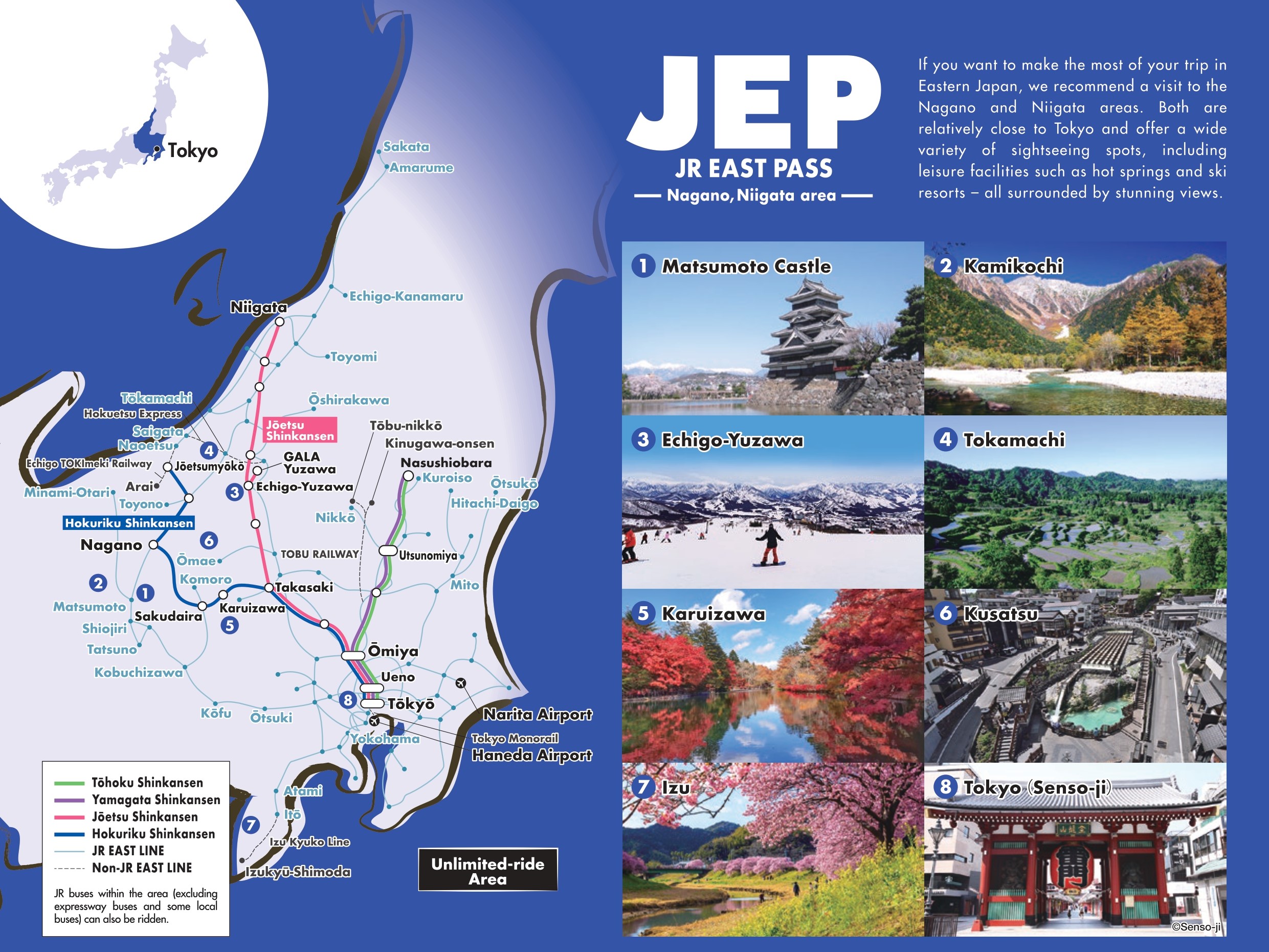
The new JR EAST PASS (Nagano, Niigata area) and usage area. (Image credit: JR East)
In addition, if you are thinking of visiting Matsumoto and the rest of Nagano Prefecture, check out the JR EAST PASS (Nagano, Niigata area), an affordable pass offering unlimited rail travel on JR East lines (including bullet trains) in the valid area for 5 consecutive days. At only ¥27,000, it makes for a great companion for rail travel around Nagano and Niigata. You can also make seat reservations for bullet trains, some limited express trains and Joyful Trains online for free, up to 1 month in advance, on the JR-EAST Train Reservation. After Kamikochi and Matsumoto, you can check out Nagano City, go shopping at Karuizawa, or feast on sushi and sake at Niigata City.

The JR-EAST Train Reservation. (Image credit: JR East)
The JR EAST PASS (Nagano, Niigata area) can be used for automatic ticket gates, and foreign passport holders living in Japan are also eligible to use this pass.
Enjoy summer with JAPAN RAIL CLUB's Omiyage Snack Box
 August's theme: Flavours of Nagano. (Image credit: JAPAN RAIL CLUB)
August's theme: Flavours of Nagano. (Image credit: JAPAN RAIL CLUB)
This August 2024, embark on a gastronomic journey to Nagano with JAPAN RAIL CLUB’s “Flavours of Nagano” Omiyage Snack Box! From Shinshu apples to the iconic shichimi spice, the snacks in this Nagano-special box will surely transport you to Nagano from the comfort of your home!
Subscribing for the first time? You can enter the promo code “FLAVOUR18” to unlock 18% savings when you subscribe to a 3-months or 6-months plan by 31 August 2024. Discover Nagano through your belly with our delicious Nagano-exclusive snack box!
Header image credit: JR East / Carissa Loh




